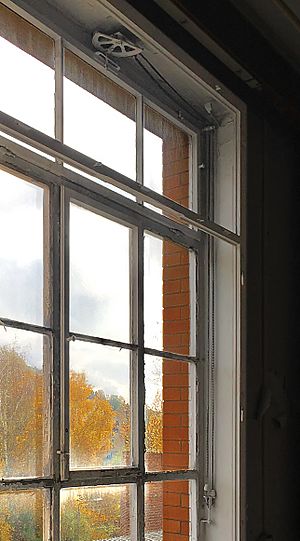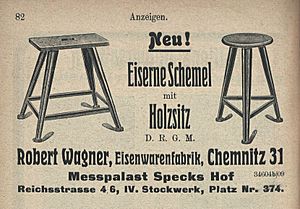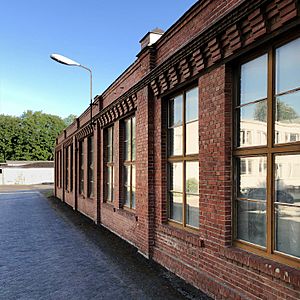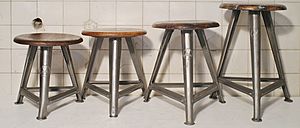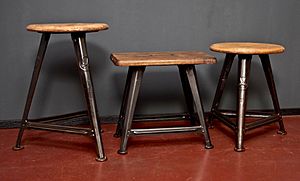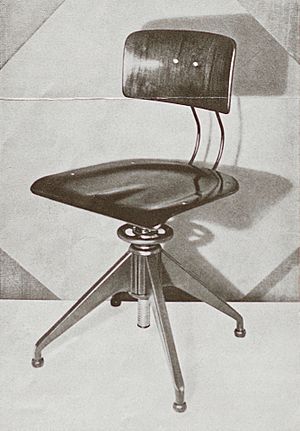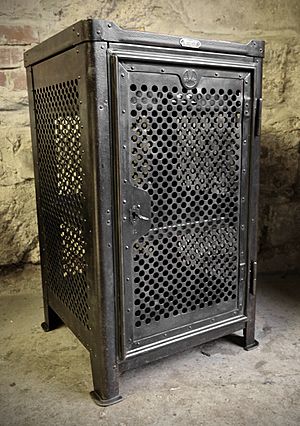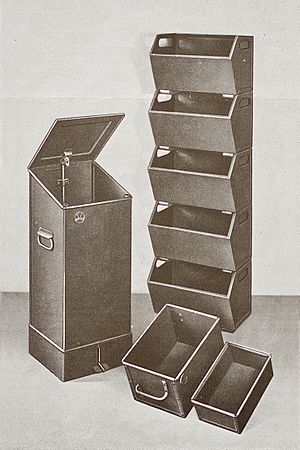Rowac facts for kids
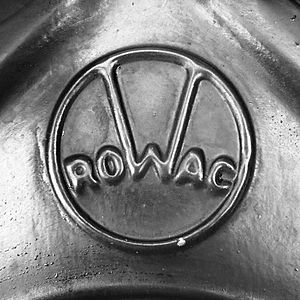 |
|
| KG | |
| Industry | Industrial Furniture & Hardware |
| Fate | Expropriation & conversion into a publicly owned company |
| Founded | 1888 |
| Founder | Carl Robert Wagner |
| Defunct | 1946 |
| Headquarters | Chemnitz, Germany |
Rowac was a German company that made strong metal furniture for factories and offices. It was started by Carl Robert Wagner in 1888 in a city called Chemnitz. The name Rowac comes from Robert Wagner Chemnitz. Rowac is famous for inventing the steel stool. This stool was even used in the workshops and classrooms of the famous Bauhaus Dessau art school. Today, old Rowac stools, chairs, and cabinets are popular collector's items. People buy and sell them as antiques.
Contents
Rowac's Story: From Small Start to Big Success
How Rowac Began (1888–1904)
On May 11, 1888, Carl Robert Wagner opened his hardware factory, Robert Wagner Chemnitz, or Rowac for short. It was located in Chemnitz, Germany. The company officially became a business on March 9, 1895.
Carl Robert Wagner started by making many different items from steel and wood. These included various locks and parts for windows, as well as crates for bottles.
By 1893, Rowac was listed as a factory that made parts for curtains. A few years later, in 1896, Rowac got a special patent for a new type of window lock. This helped the company quickly gain many happy customers. It also helped Rowac stand out from other companies.
In 1898, a newspaper called the German Construction Newspaper wrote great things about Rowac's window lock. Older window locks often had problems, but Rowac's "Wagner'sche Verschluss" was much better. It was especially good for opening large, heavy windows high up in buildings. These windows were found in places like churches, concert halls, hospitals, and gyms.
The best part was how easy it was to use. You just pulled a chain, and the window would open or close easily. Plus, it cost less than other similar systems. Rowac's window locks were installed in many famous buildings in Dresden. These included the Residence Palace and train stations.
Rowac became very popular, and the demand for its products grew quickly. The company had to move its factory several times within Chemnitz to bigger locations. Finally, in 1900, they settled in Altchemnitz. Here, a modern factory was built by architect Wenzel Bürger. In the same year, Carl Robert Wagner received an honorary certificate and a gold medal from an exhibition in Leipzig. Old Rowac brochures even show praise from royal and city officials across Germany.
Making Steel Furniture (1905–1938)
Over time, Rowac started focusing more on making steel furniture and equipment for factories. They became experts at creating comfortable seats for workshops and offices. Rowac showed its products at the Leipzig Trade Fair at least once a year.
The Rowac stool became very famous. It is known as the first steel stool ever made in a factory. It was widely used in the 1920s because it was much stronger than simple wooden stools. Wooden stools often broke or had loose legs and needed constant repairs.
In 1923, famous architects Max Taut and Franz Hoffman chose Rowac stools for an office building in Berlin-Mitte. Even more notably, in 1926, Rowac stools were placed in the classrooms and workshops of the Walter Gropius-designed Bauhaus building in Dessau.
At its busiest, Rowac employed up to 175 people. Besides stools, Rowac also made chairs, tables, and benches from steel. These were used in break rooms and other areas. The company also produced tool cabinets, waste bins, and various crates for bottles and spools. In 1925, a textile industry newspaper praised Rowac's boxes for transporting and dampening spools.
Rowac's products were sold to almost all European countries. However, the company faced challenges when the Great Depression affected Germany. In 1931, Kurt Robert Wagner, Carl Robert Wagner's son, spoke about the economic problems in Saxony.
After Carl Robert Wagner passed away in 1931, his son, Kurt Robert Wagner, and his grandsons, Hans Kurt Wagner and Werner Alexander Wagner, took over the company. Rowac continued to focus on "creating healthy workstations." This idea was even mentioned as a great example in books about office hygiene in 1931.
War and Changes (1939–1946)
During World War II, Germany stopped companies from making steel furniture. This made it hard for Rowac to supply its customers across Europe. A letter from 1941 shows that Rowac had to switch from using steel for swivel chair frames to using beech wood instead.
Rowac kept operating during the war because it made items for the navy, air force, military, and other government groups. These items included different boxes, tables, and benches, which were also used in air-raid shelters. However, in 1946, the company was taken over by the government. It was renamed VEB BEMEFA, which stood for "industrial equipment and hardware factory." In 1990, BEMEFA became a private company again and still makes metal furniture at the same location.
Rowac Today
Today, Rowac products are collected as antiques and displayed in museums. Some original stools from the Bauhaus building are kept in the Bauhaus Dessau Foundation archives. The Museum of Applied Arts in Vienna has a Rowac stool and an old advertisement stamp. A Rowac bottle crate is in the Kreismuseum Bitterfeld. The Delft University of Technology in the Netherlands has a Rowac stool in its chair collection. You can also see many Rowac stools in the Industrial Museum in Chemnitz.
The original Rowac factory building, built in 1901, is now a protected historic landmark. It is still used by bemefa Metallmöbel GmbH to make metal furniture. In late 2015, a company in Leipzig worked with the original copyright owner to bring back the Rowac folding stool.
Rowac's Products
Stools
Rowac proudly called its stool the first steel stool ever made and sold. The first model, a three-legged stool with a round wooden seat, was designed in 1905. It was first shown at the Leipziger Michaelis-Messe in 1909. Rowac advertised the stool by saying: "Work that can be done just as well sitting down should never be done standing up."
At first, selling this new product was a bit of a risk. But by 1909, a watchmaking journal praised it for being very strong. It lasted much longer than simple wooden stools used in workshops. Also, it saved money because it rarely needed repairs. Rowac stools became very popular, especially in workshops and factories, by the 1920s.
Today, the three-legged stool is one of Rowac's most famous products. It came in different heights and even with a backrest (Model IV). There was also a four-legged version with a rectangular wooden seat (Model II) and a folding stool. For special uses, there was a height-adjustable swivel stool (Model III). A rare version, Model Ib, was welded instead of riveted like the others.
Rowac stools (Models I, II, III, and IV) have U-shaped legs that get wider at the top. They also have L-shaped metal supports that connect the legs. This design, made from strong, riveted steel, makes the stools very stable. The legs have special folded feet that protect floors. The rounded parts of the base also prevented damage to clothes and shoes.
The wooden seat (first solid wood, then plywood) is attached to a metal plate with screws. The basic design of the Rowac stool stayed the same over the years. However, parts like the feet, legs, and seat were improved. For example, the foot was first round. In the 1930s, it changed to a patented semicircular foot for even more strength.
The design of the Rowac stool is simple and practical. It was made for factories, not for fancy display. But at the Bauhaus and in Max Taut's office building, the Rowac stool became a symbol of good design. From the 1920s on, Rowac often stamped its logo on the legs or base plate. This showed it was a quality product and helped it stand out.
Chairs and Swivel Chairs
Rowac also made chairs with flexible backrests for workshops and offices. The first ones were strong steel work chairs (Models X and XI) with curved backrests. These were mainly used in workshops. The steel chair (Model XI a) was used in break rooms.
The second type was the swivel chair (Models XII a and b). On these chairs, you could adjust both the seat height and the backrest. Model XII b even had a backrest that could move up, down, and side to side. You could change these settings easily by hand, without any tools. The goal was to help people sit in a healthy, straight position. These chairs were also very comfortable because the wide seat had a springy feel, almost like an upholstered seat.
During World War II, when steel furniture production was banned, Rowac had to use beech wood for the chair frames instead of steel. A rare example is the armrest swivel chair (Model XVI). This chair was used in the famous Feuerhand factory in Germany. Like the stools, the chairs were also designed to protect clothes, shoes, and floors.
In 1931, a health journal wrote about how important it was to choose the right office chairs. It said chairs should have enough space under the desk and no armrests that get in the way. The Rowac typewriter swivel chair was mentioned as a good example. Doctors also checked Rowac's steel chairs and found them to be healthy to use. The company even received patents for things like its flexible backrest.
Tool Cabinets and Tables
Factories often needed many different tools for machines like metal lathes and drill presses. Rowac made tool cabinets and tables to help workers keep tools organized. This saved time and made work easier. These products were known for being well-designed, strong, and long-lasting.
Rowac offered these cabinets in many different styles. They came in various sizes and could have perforated (holed) metal panels (Models No. 4+5) or solid steel panels (Models No. 6-8). They could have steel shelves, with or without drawers (Models No. 4-8). The drawers could be made of steel or wood, and the doors could be locked. Models No. 2, 4, and 5 had a strong hardwood top for working on. Models No. 6-8 had a plywood top. A rare item was the wall-mounted tool cabinet. Another rare product was a folding table with a wooden top and colored linoleum, used in break rooms.
Containers and Bins
Factories used many containers to store and move small parts. Wooden containers often broke after heavy use. So, Rowac created strong metal containers instead. Factories also used cotton wool soaked in flammable oils for cleaning. To prevent fires, Rowac made special fireproof bins for storing this used cotton wool.
Rowac offered many types of containers and could even make custom ones for customers. For example, transport containers came in different sizes. They could be tapered (narrower at the bottom), have handle openings, and even have inside compartments. Customers could choose different materials (plain or galvanized steel) and thicknesses. They could even ask for oil-tight welding. All transport containers had a strong metal rim at the top to make them last a very long time.
Open-front storage boxes also came in different sizes. They had handle openings and two hardwood rails on the bottom. The cotton wool bins had a handle on each side and a stamped label. They came in three types, with an automatic closing lid or a foot pedal to open the lid. The galvanized waste bins were very sturdy. They had a swing-open lid with strong hinges and firm handles on the lid and sides. They could also have a hook for hanging.
Crates for Drinks and Textiles
Rowac also received patents for different crates used by breweries (like Dresdner Felsenkeller), dairies (like Genossenschaftsmolkerei Chemnitz), and spinning mills. As early as 1906, Rowac was making beer bottle crates.
Rowac and the Bauhaus School
The design of the Rowac stool perfectly matched the "functionalist" idea. This idea was popular in Germany between the two World Wars, especially at the Bauhaus school. Functionalism meant that things should be designed to be practical and useful first, and then look good.
Starting in 1926, Rowac stools were used in the classrooms and workshops of the Bauhaus Dessau. This was one of the most important art schools for modern design. Walter Gropius, the founder of Bauhaus, chose the Rowac stool because of its clever but simple design. Rowac even advertised its stool in a Bauhaus brochure, saying: "the tried and tested rowac stools are in use in all rooms of the bauhaus!" Photos from the Bauhaus Archive show that Rowac stools were used not just for sitting, but for many other activities by students and the school's band.
Why Metal Furniture Was Important
In the mid-1800s, furniture making changed a lot because of new machines. As factories grew, there was a greater need for furniture that was useful and durable. Rowac was one of the first companies to mass-produce industrial furniture, and it became very well-known.
Factory furniture helped workers in many ways. For example, it prevented them from getting tired too quickly if they had to stand for long periods. It also helped organize tools, saving space and time. The type of furniture chosen depended on the specific job. Sometimes, chairs with backrests or armrests were used if they helped workers do their jobs better.
In the 1930s, experts started studying ergonomics. This is the science of designing workplaces to fit the worker. They realized that special furniture could improve work and prevent posture problems. So, height-adjustable stools and chairs with backrests became more common. However, they were only used where they clearly helped improve work or prevent injuries. Rowac also started making these more complex and costly options.
Metal furniture, like toolboxes, filing cabinets, lockers, shelves, tables, and various chairs, was used not only in factories. It also became common in public places like offices, schools, nursing homes, hospitals, and restaurants.
Rowac's Patents
If you look at the online archive of the German Patent and Trademark office, you can find many patents registered by Rowac. These patents were for details of their stools and chairs, but also for other items like bottle crates, spool crates, and window fasteners.
For example, in 1920, Rowac received two patents for how the legs of their steel stools were attached. These patents meant the stools could be shipped unassembled. This saved space and reduced shipping costs, especially for large orders. Workers could then easily put them together at the factory using only screws, without losing any strength. However, it's not clear if this method was widely used in actual production.


